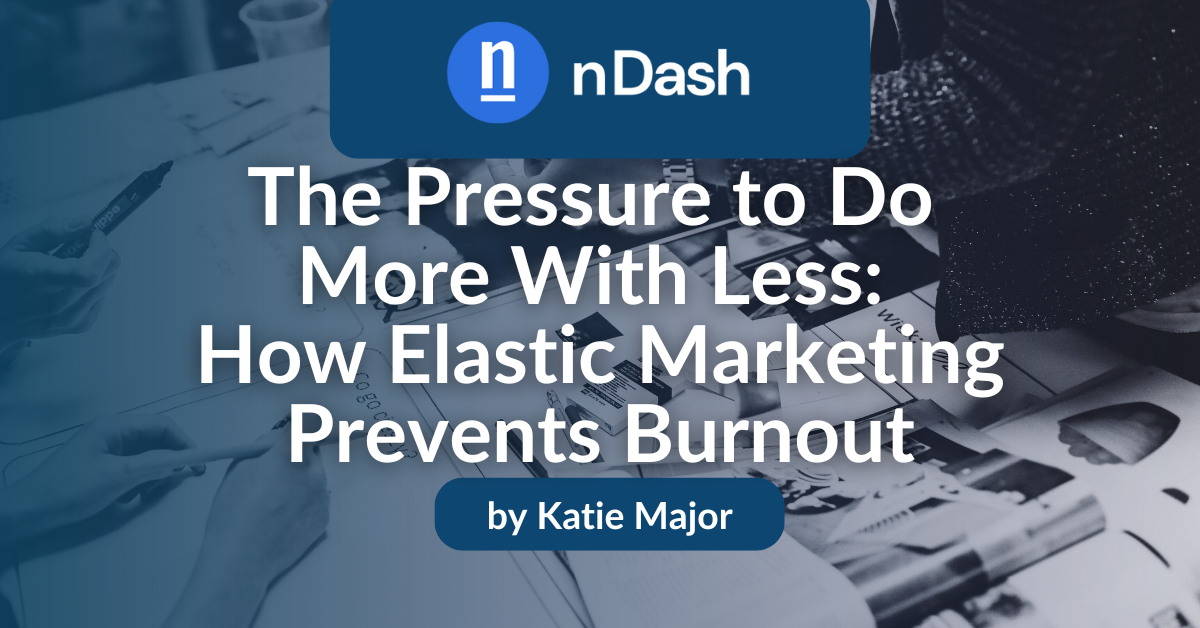Marketing leaders are no strangers to pressure. Elastic marketing offers a way to manage that pressure without sacrificing performance or burning out your team.
Yet, the pressure has been firmly on for a while now. The last few years have seen CMOs try to do more and more with less. The average marketing budget has slumped down to 7.7% in 2025 from 11.2% in 2018. Gartner aptly dubbed this period “the era of less.”
The day-to-day reality of this era of leaner teams, all with the same or higher performance expectations.
This blog post will discuss another day-to-day reality of increasingly lean budgets: marketing team burnout. We’ll also look at how elastic marketing models (flexible, modular team structures) help protect core teams from overload.
TL;DR
- Marketing budgets fell from 11.2% in 2018 to 7.7% in 2025, pushing teams to do more with less.
- Burnout is a capacity issue, not a resilience one.
- 60%+ of marketers feel overwhelmed; 50%+ report emotional exhaustion.
- Traditional hiring can’t keep pace with shifting campaign demands.
- Elastic marketing matches resources to workload in real time.
- Flexible, modular teams prevent burnout and sustain creativity.
- The goal isn’t doing more, it’s doing the right work with the right support.
Low Morale + Burnout = Weak ROI
Productivity might survive a rough quarter rife with tight deadlines and limited team resources, but morale might not.
Marketing Team Burnout Is a Capacity Issue
MarketingWeek surveyed over 3,500 marketers and reported that over 60% of them, regardless of seniority, feel overwhelmed. Over 50% report emotional exhaustion.
When expectations keep rising and resources keep shrinking, burnout becomes inevitable. It’s not about “resilience” or “pulling up your bootstraps,” it’s about the realistic capacity of your team.
When teams are expected to produce the same amount of results with fewer resources, stress is a constant companion. It’s not sustainable.
Signs Marketing Teams Are at Their Breaking Point
You’ll start to see this in action before the quarterly reports show it:
- Deadlines slip
- Internal comms become shorter, with less team engagement
- Briefs become shorter
- Team members quietly check out or quit altogether
- Increased reactivity in creative campaigns and in response to stakeholder pressures
Another powerful indicator of burnout is a lack of innovation and energy. When your team doesn’t have the capacity to think outside the box, they will use tried-and-true as a safety net. Or they’ll rely on AI tools in situations where they ordinarily wouldn’t need to.
How the “Do More With Less” Mandate Became Normal
CMOs today are expected to deliver growth while managing budgets at unprecedented lows.
The Budget-Performance Disconnect
According to a 2024 Gartner survey, 64% of CMOs say they don’t have the budget to hit their strategic goals. Yet KPIs continue to climb.
The result is short-term thinking, stifled creativity, high team turnover – but with the same growth expectations we had in 2017.
Why Traditional Hiring Models No Longer Work
Campaign turnaround expectations have never been higher and will often require highly specialized skills to execute effectively.
Hiring a full-time employee is time-consuming and expensive. Indeed, the average time-to-hire is between 30 and 45 days, and by that time, priorities will have changed. Not to mention the onboarding, training, and all of the other hoops that come with a new hire.
As budgets run thin and result expectations remain high, many CMOs turn to their current teams to help with overload. Asking your team to take on tasks that don’t suit their skillset is a fast track to team burnout and low job satisfaction.
Yet, if you have a task that needs doing and an already overloaded in-house team, where do you turn?
What Is Elastic Marketing, and Why It Relieves Pressure
Enter elastic marketing, a modular, structural approach that matches capacity to actual demand without overwhelming your core team.
It’s a flexible marketing team model that keeps strategic control in your hands. You tap in talent as needed to fulfill skill gaps.
Think of it as “turning on the tap” when demand is high, and turning it off when it’s time to scale down.
Flexible Resourcing, Not Reactive Outsourcing
Elastic marketing isn’t just about finding last-minute freelancers to help once or twice. It means you can build a proactive, modular team structure that exists in tandem with your core team.
This looks like trusted, long-term contractors and creative partners who know your brand inside and out. They can step in when needed.
Focused Teams Mean Better Creative Work
When your in-house team isn’t stuck doing everything, they can do their best work.
Over time, campaigns become more innovative, and team morale improves. With an elastic team to lean on, your core team will once again thrive in their roles.
Burnout Prevention is Performance Protection
When you protect your team’s energy, you protect overall outcomes. Elastic marketing keeps your team sharp, motivated, and energized while your elastic team scales up and down as needed.
Real-World Elasticity in Action
So, what does elastic marketing look like in practice? Let’s look at three common scenarios that show just how valuable this model really is.
Using Elastic Support During Campaign Peaks
Need extra hands during a product launch, event season, or end-of-quarter push? Elastic teams bring in trusted writers, designers, or strategists without slow hiring or the risk of burning out your team.
Protecting Creative Energy Between Big Moments
Between launches, elastic models prevent teams from falling into mind-numbing busywork. They maintain momentum with focused tasks and reduce pressure to “fill the calendar” just for the sake of activity.
Building a Sustainable Bench of Support
Elastic teams, while much more agile than hiring internally or onboarding an agency, still take time to develop.
Smart marketing leaders build trusted contributor networks over time via platforms like nDash, internal referrals, or hybrid agency models.
This foundation gives them confidence to scale intentionally and proactively.
Why Protecting Morale Is a Strategic Advantage
Burnout has a negative impact on businesses worldwide. Elastic marketing is how CMOs can mitigate this very real risk while also executing powerful campaigns – without overreliance on AI.
Reduced Turnover, Higher Engagement, Less Reliance on AI
When employees feel supported and resourced, they stay. They engage more deeply with the work, their own creativity, and the brand mission. And they’re far more likely to take creative risks that pay off.
AI tools are often seen as saviors or replacements for team members. The truth is, while a helpful tool, we’re still in the early days of AI. Plus, there are still big questions being asked about the ethics of how AI is trained.
Moreover, the savvy consumer is becoming increasingly adept at spotting AI-generated text and images. An elastic marketing team lets you conserve budget while reaping the rewards of an engaged, happy team. AI can go back to being a helpful tool rather than a necessary requirement to scale.
Elastic Marketing = Sustainable Marketing in 2026
The next few years will be instrumental for marketing teams. The current system isn’t working, but campaigns are now moving faster than ever. We know that the pressure isn’t going anywhere. But burnout doesn’t have to be the outcome.
Elastic marketing helps modern teams scale, adapt to strict budgets, protect their teams, and bring creativity back into workflows.
FAQs About Elastic Marketing
How is elastic marketing different from using freelancers?
Elastic marketing relies on building a network of trusted experts who can step in as needed—unlike one-off freelance projects, these contributors become extensions of your core team.
How does elastic marketing improve ROI?
By preventing burnout, reducing turnover, and keeping teams focused on high-value creative work, elastic marketing increases both output quality and consistency without adding headcount.
Can small or mid-size marketing teams use an elastic model?
Absolutely. Elasticity is scalable by design. You can start small by adding one or two reliable contributors and expand as campaign demand grows.

About the Author
Katie Major is a versatile marketing professional with a passion for content creation and strategic storytelling, and she leads creative initiatives as Founder at Major Marketing. To learn more about Katie — and to have her write for your brand — be sure to check out her nDash profile page.
